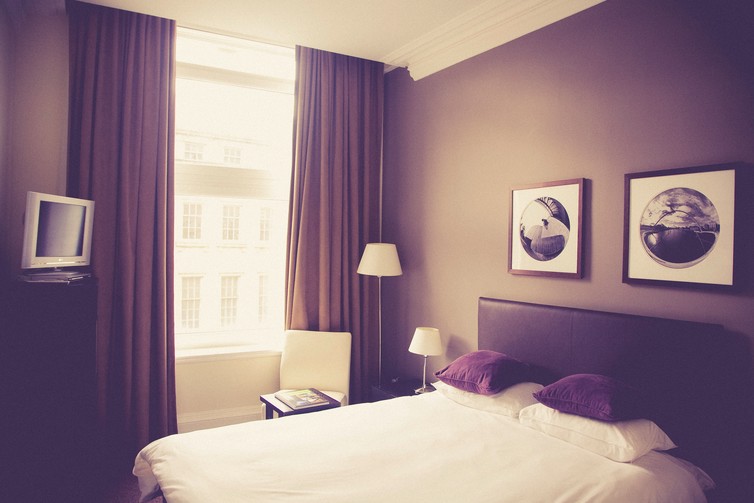Have you ever arrived in a hotel room after a long flight and, despite being exhausted, found it painfully difficult to fall asleep? And even once you managed to get to sleep, did you still wake frequently in the night, or too early in the morning, feeling groggy and desperate?
Researchers have long known about this phenomenon in an experimental setting, terming it the “first-night effect”. Sleep study participants often sleep poorly during their first experimental session in a new environment and sleep quality usually improves dramatically on the second night.
So what happens in the brain when people sleep in a new place? In our study, published today in Current Biology, we found poor sleep in an unfamiliar setting may be linked to an important function of the brain to protect the sleeper from potential danger.
The first-night effect
Studies have indicated unilateral hemispheric sleep in some birds and marine mammals, where one hemisphere of the brain sleeps while the other is awake.
This peculiarity has been connected to a survival strategy. Some birds show unilateral sleep in risky situations, such as when they sleep at the dangerous edge of a group rather than in the middle, so that the waking hemisphere can detect predators while the other half rests.
We hypothesised that something similar may be happening in the human brain during the first-night effect. Perhaps when people don’t know whether a new place is safe or not, an inbuilt internal surveillance system kicks in.

So we tested whether one brain hemisphere sleeps lighter – also known as interhemispheric asymmetry – during a person’s first night in a new place.
The first experiment
A human brain is divided into two hemispheres, the left and right. Some parts of the left hemisphere are associated with language processing and some parts of the right with spatial information processing, or processing of the surrounding environment.
We used an advanced neuroimaging technique to detect the depth of sleep in the brain hemispheres of 35 young, healthy participants over two nights, conducted about one week apart. The sleep sessions weren’t sequential so that any effects from the first session would not be carried over to the second.
The technique combined magnetoencephalography (MEG), that measures changes in the brain’s magnetic field; magnetic resonance imaging (MRI), that measures structural brain information; and polysomnography, that measures general sleep status.

The technique measured slow-wave activity that indicates depth of sleep. When slow-wave activity is strong, sleep is deeper; when it is weak, sleep is lighter. We found the left hemisphere of participants’ brains slept lighter than the right on the first night.
Depth of sleep was also measured in different brain networks. Brain networks are composed of several different brain regions but they work together. One of these – the default-mode network – is linked to spontaneous mind wandering. So if someone’s mind wanders spontaneously, the default-mode network may be activated.
We found it was the default-mode network that slept less when the left hemisphere slept lighter, suggesting the mind was wandering – or on some form of alert.
We also found participants with stronger interhemispheric asymmetry in the default-mode network slept worse. The interhemispheric asymmetry in the sleeping brain was seen only on the first night when the environment was new. During the next session, everyone slept soundly.
Did the left hemisphere sleep lighter during the first session because it was monitoring the environment? If so, this hemisphere would also be able to react to subtle signals. We tested this possibility in the next experiment.
The next experiment
While participants slept, they were presented with two different beep sounds through earphones. One sound was of a high, unusual frequency, while the other was an ordinary frequency sound.
Most of the time, the participants would hear the normal sound, but once in a while, we would present them with a rare sound. We then measured how much each hemisphere responded to either sound.
We found the lighter-sleeping (left) hemisphere was more alert than the right when presented with an unusual sound. It actually responded strongly to unusual sounds but not as strongly to ordinary sounds. Again, these effects were only seen during the first sleep session and not the next.

The first-night effect is well known in research. Markus Spiske/unsplash, CC BY
Then we wondered whether this vigilance meant people could wake and react faster to unusual signals in a new place. We asked participants to tap their fingers when they heard a sound. Like in the previous experiment, beep sounds were presented through earphones while participants were asleep.
In the first session, participants woke and tapped their fingers faster to an unusual sound than on the second, when the room had become familiar. And these were linked with the left hemisphere detecting the sounds.
We also noted participants’ anxiety levels weren’t any different between the two sleep sessions, so it’s unlikely this is a factor.
Like some animals, the interhemispheric brain asymmetry that happens on the first night in humans might act as a security guard to protect them from danger.
This article was originally published on The Conversation. Read the original article.
Is sleeping| more important |than studying?
Vote now-
Read More
- Mythbusting: 5 sleep 'facts' debunked
- Why sleep could be the key to tackling mental illness
- Creativity: sleep-fuelled or sleep-deprived?
- Humans and hibernation: 4 reasons we don’t sleep through winter
- 9 top tips for sleeping
- Self-preservation and sleeping in weird places.
- Slumbering stories: these books say sleep has the power to…
- Is sleeping more important than studying? Take this further...
-
Watch More